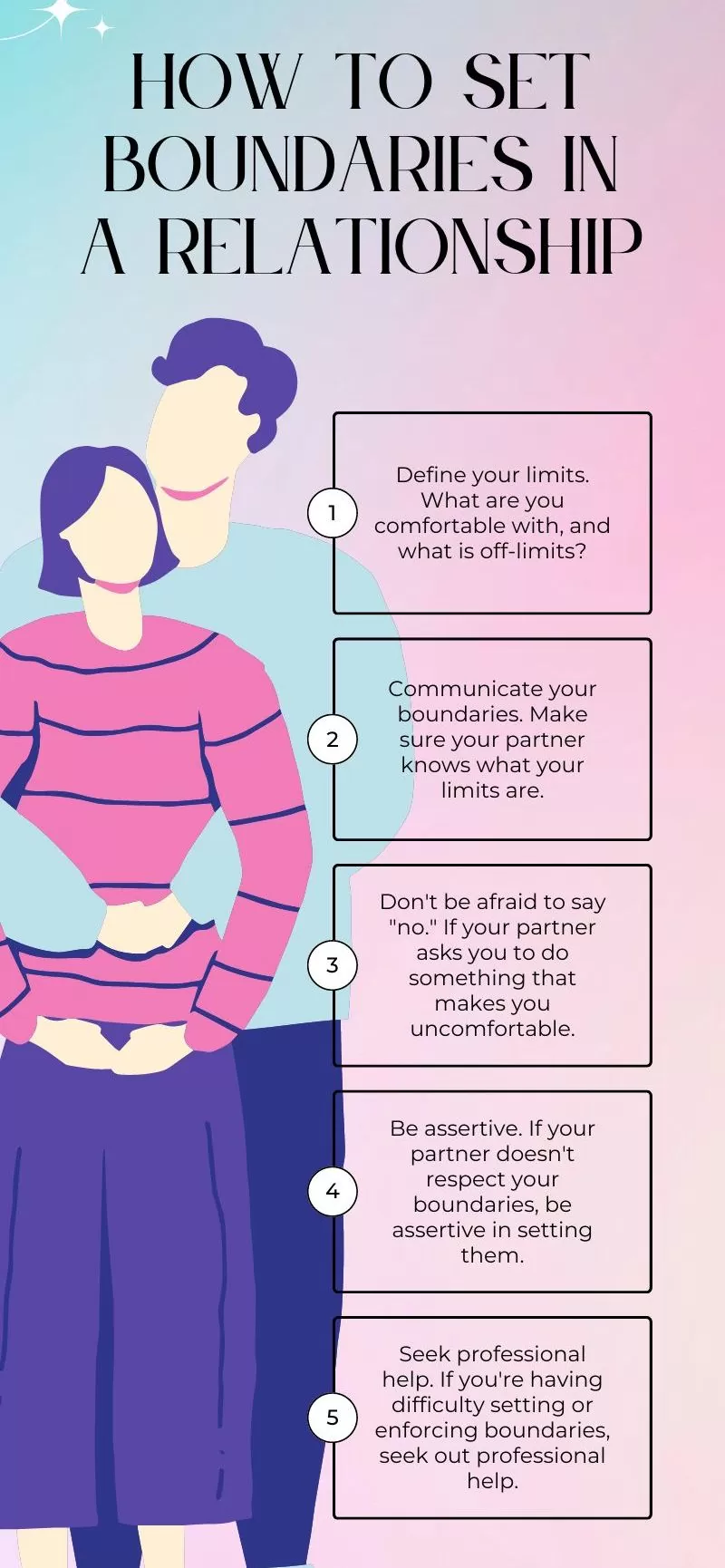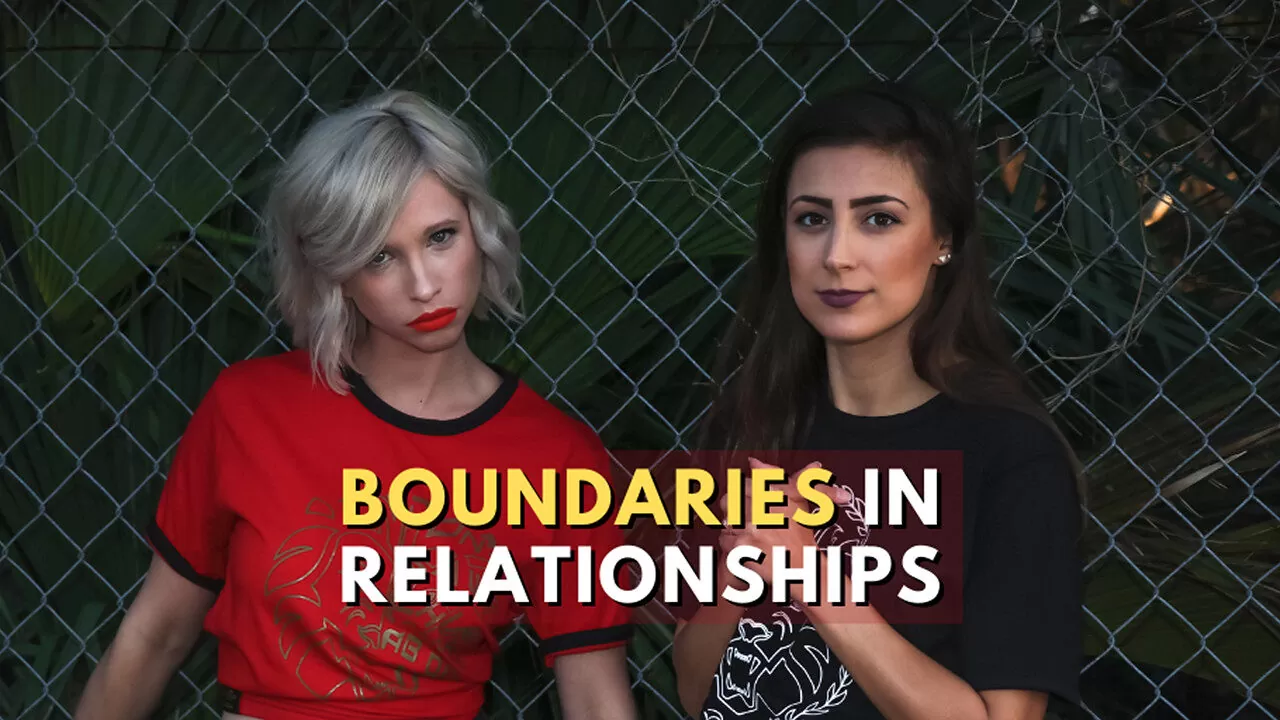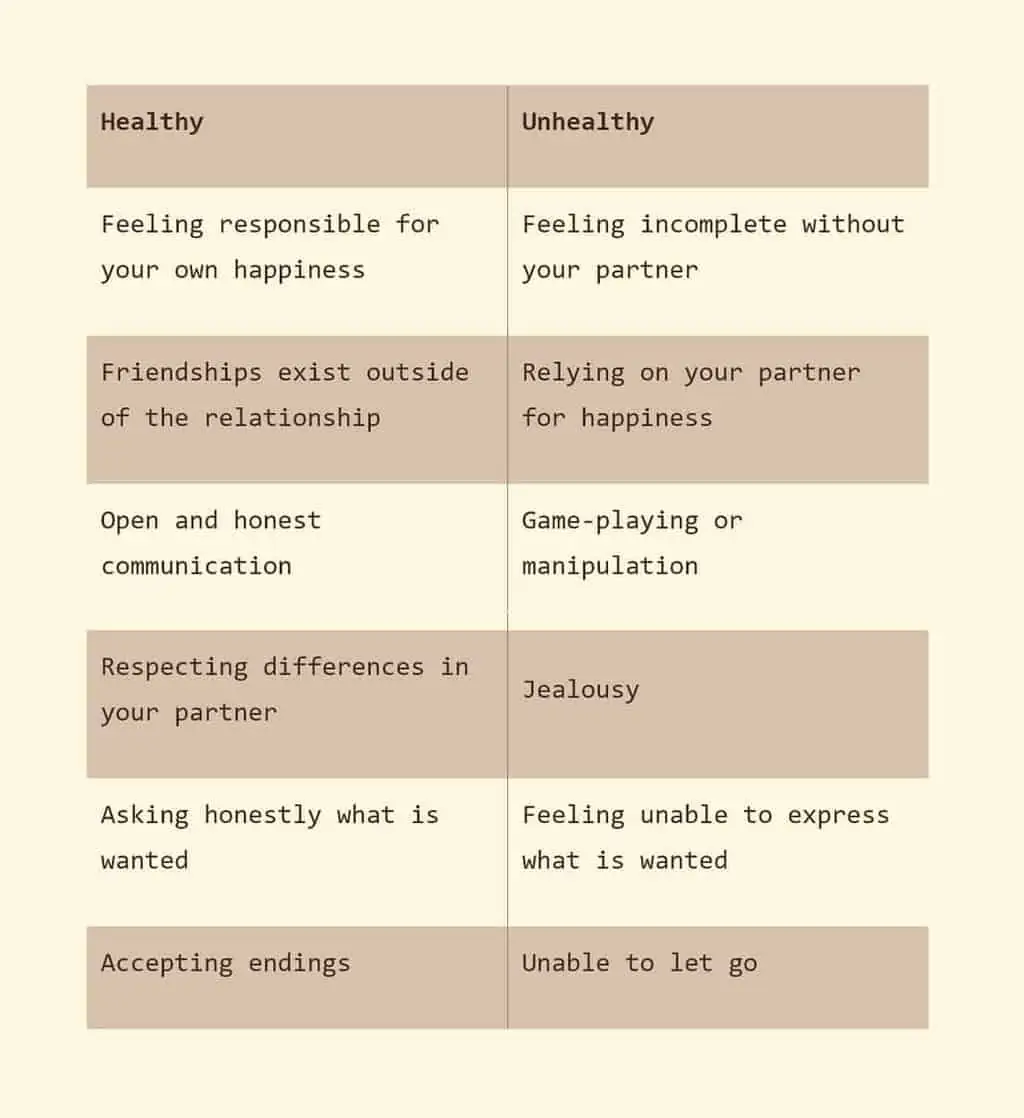Today's Saturday • 18 mins read
— Researched and reviewed by Dr. Sandip Roy.
Learn how to set boundaries in a relationship without being controlling. Discover the seven relationship boundaries and have a fulfilling and harmonious life.
John Donne, a 17th-century poet, reminded us:
“No man is an island, entire of itself, every man is a piece of the continent, a part of the main.”
You and I both need other people in our lives because first, none of us is truly self-sufficient, and second, relationships give us love, support, and belongingness.
However, you must not give up your autonomy or uniqueness to have meaningful connections. And setting healthy boundaries is that strategy to maintain the “you” in your relationships.
Table of Contents
How To Set The 7 Boundaries In A Relationship Without Being Controlling?
You must set boundaries in every relationship of yours, whether it be friends, partners, colleagues, spouse, siblings, parents, or children. Even the casual acquaintance must have boundaries.
It’s hard to set boundaries when a good relationship starts to go bad. During those times, you want to limit how much you will accept without pushing them away or controlling them.
Here’s how to set 7 boundaries in a relationship without being controlling:
1. Financial Boundary
Setting a financial or money boundary in a relationship is an essential modern virtue.
I feel stressed asking a friend to return my money. Meanwhile, I’m confused as to why they won’t say anything about paying it back. It could be you.
Now, while I can’t undo my past money-related behavior, here are three rules I’ve set for myself to follow when someone outside my close family asks me for money:
- Don’t lend money to friends – A loan to a friend can make you you lose both the money and the friendship. Offer them other ways to help, such as advice or connecting them with resources.
- Loan what you can comfortably lend. Do not borrow or break your savings to lend them money. Always set clear repayment terms – timeframe, interest rate, and conditions in case of payment failure.
- Only lend what you can afford to lose. If you have any doubts about their inability to repay you, and you still want to help them out of goodwill, lend only what you can afford to lose and not feel bad about it. Nevertheless, even when you’re giving them your hard-earned money without expecting it back, ask them when they can return it.
The golden rule is to always ask, “If I decide to loan you money, when can you pay me back? And what steps can I take if you do not honor it?”
Of course, financial boundaries go both ways: you set how much you can spend out for charity or loan out to others, and gracefully accept those money limits that others set for you.
- Is it necessary to have a joint bank account with your spouse after your marriage? – Yes, but you must also maintain your separate accounts.
- Should you always give money to your friends and/or family when they ask? – No, especially when you cannot bear the financial stress on yourself. Strictly no when you know they are exploiting you.
- Is asking for a written agreement “unfriendly”? – No, putting an agreement in writing in an email, a message (take a screenshot and save it), or a paper or electronic document, will help avoid future misunderstandings and conflicts.
Money boundaries secure your financial future, mental peace, and even physical well-being (in terms of health insurance).
They help you have enough money for yourself and prevent you from indiscriminately giving it away to others.
They help you reach your annual financial goals, build a retirement corpus, pay off debts, buy health insurance, and have an emergency fund.
- Don’t lend money unless you have assessed your financial and emotional risks.
- Don’t feel obligated to give someone money that you don’t have, borrowing for them.
- Don’t empty your bank account for someone you’re dating or a distant relative who asked for it.
Be prepared to say no if you are not comfortable with the risk. Saying “No” without being rude to anyone seeking your monetary help will let you secure your financial future as well as maintain healthy relationships.
Here are three financial rules that Ramit Sethi (of I Will Teach You To Be Rich) gives:
- Save and invest a portion of all income. Save 10% and invest 20% of your income. You can adjust these numbers to fit your own situation. Sethi says this straightforward habit can help you build your emergency savings and eventually get rich.
- Set financial goals. Think deep and write down what you want to achieve with your money? Do you want to buy a house? Pay off debt? Retire early? Once you know what you want to achieve, you can start to make a plan to reach your goals.
- Automate your finances. Set up automatic transfers from your checking account to your savings account and investments. This way, you won’t even have to think about it. This will help you stay on track with your savings and investments.
2. Personal Growth Boundary
This is also known as the boundary for personal space for growth.
Understand the importance of personal space. Personal space boundaries give you the flexibility and freedom to establish your personal priorities and balance the needs of yourself and others.
Healthy growth boundaries help cultivate respectful love for each other.
They are necessary in intimate and romantic relationships, as both people get to discover and learn more about themselves, thrive in shared experiences, and preserve personal expression and freedom of choice.
Your loved ones should know when it is wrong to interrupt you or ask you for certain things, so they do not hinder your personal growth and pursuits.
You can give priority to your goals and dreams, even within a romantic relationship or family, as long as it doesn’t come at the expense of your loved ones.
It also includes time boundaries, meaning how we manage our time. As they say, there’s a time to play. And there must be times for work, love, passions, and doing nothing.

These are how to set your growth boundaries with your close people:
- Most relationships do not require full disclosure, and simply being together does not entitle them to demand that you disclose all of your passwords to them.
- Your family means the world to you, but you don’t have to sacrifice your personal growth aspirations to meet their needs and desires.
- You have to openly communicate your needs and desires to boundaries to people in your life, for living and growing with a free and fearless mind.
- Set clear expectations by discussing the amount of time, space, and energy you need to grow. Tell them in writing so there is little scope for misunderstandings and conflicts.
- Be ready to politely decline if you don’t feel comfortable giving up your free time for something they are asking of you, unless it is an urgent situation. It is okay to say no and offer alternative ways/times to help.
- Encourage personal growth for both, giving each other the opportunity to recharge your emotional batteries, nurture your individuality and independence, and develop a sense of self-worth.
If someone is not giving you the freedom to grow, leave them. Your mental health is best served by cutting toxic people out of your life.
A little note: You have every right to set boundaries, and you never need to apologize for setting them.
3. Digital Boundary
The world is a global digital village today. Your presence or absence is no longer defined by physical walls and doors.
The internet has allowed people from opposite sides of the world to check out each others’ activities and creations on social media.
This necessitates a new type of boundary – digital boundary.
Set ground rules for online social interactions with loved ones, friends, and acquaintances. Establish and enforce boundaries for your fans, followers, and connections.
Start by asking yourself: “What do I like/dislike about my social media connections?”
Once you have the answers, open a conversation with them about acceptable online behavior.
Ask them:
- Can you stop tagging me in your posts?
- Can you not add me to a group chat without first asking?
- Can you stop going through my devices without permission?
To keep a romantic relationship responsible and nonintrusive, set clear digital boundaries by mutual consent.
- Do we need to announce on social media that we are dating?
- When is it okay to call or message each other at certain times?
- Do we have to reply every time, even when I feel it is unnecessary?
- Do we have to follow each other’s friends and relatives on social media?
- Do I have to like and comment on all your posts, even if I do not want to?
3. Emotional Boundary
Playing with other people’s emotions is simply wrong. Emotional boundaries put up a fence around your feelings and emotions.
These boundaries keep others from hurting your happiness and peace. They prevent others from telling you to “get over it” when you are in grief.
Emotional boundaries are violated when someone criticizes, belittles, or invalidates another person’s feelings.
You don’t need to apologize for setting up an emotional boundary.
Don’t say, “I am sorry,” when you set up your boundary, “… but could you please not call me up to talk about your dramas with your mother-in-law?”
Having an emotional boundary in place allows you to have some alone time without having to explain if you are feeling stressed or upset.
Your smiles and tears are first of all yours, and you are not required to explain them or say sorry for them.
Similarly, unless you know them well, don’t ask a coworker or friend why they are upset or crying. Don’t go digging to find out what’s wrong with someone; it may invade their personal space.
When someone of the other gender uses endearing language, many people, particularly women, find it offensive and consider it harassment.
You don’t need to allow others to use language or phrases that make you uncomfortable, whether it is derogatory or endearing.
- Boundaries help relationships be respectful and autonomous. They let people maintain their personal space, time, choices, opinions, and activities within the relationship.
- Boundaries give relationships balance and equity, prevent misunderstandings and conflicts, and allow comfort and security for both.
Irreverent phrases (like colloquial insults and name-calling) can send the wrong signals to your loved one and express an entirely different idea than what you intended.
As a general rule, when setting emotional boundaries:
- be clear and specific;
- be firm and direct;
- do not negotiate;
- do not apologize.
4. Mental/Intellectual Boundary
Intellectual or mental boundaries refer to thoughts, ideas, and opinions.
Everyone is different and has different perceptions and opinions. Healthy mental boundaries ensure we do not feel pressured to conform to someone else’s viewpoints.
These boundaries are violated when someone dismisses or belittles another person’s thoughts or ideas.
If someone feels strongly about an idea, ask them to back it up with facts and present it in a fair and decent way without belittling you or anyone else.
Don’t let anyone shout you down with their unproven opinions as final proof.
Request that they disagree with dignity. If they still try to parade their ideas as superior, making you feel trivial or stupid, leave the scene.
Having mental boundaries not only protects your own mental wellness, but also shows your consideration for the well-being of others.
Remember, you can always review your mental boundaries and adjust them as relationships evolve.
Your mental wellness comes before your social relationships.
6. Physical Boundary
Your body is yours, and only you decide who gets close to it.
Physical boundaries are meant to protect your body, privacy, and personal space. By setting physical boundaries, you show them how to respect your comfort and privacy.
This includes marking the line between your availability in private and public spaces. It makes clear what behaviors are acceptable, such as hugging or using personal items.
Most of us dislike people invading our privacy or getting too close to our personal space. To avoid that, we should set our physical boundaries.
- Do you hate others using your items? Then let them know.
- Do you dislike people hugging you? Then you must make it clear to them.
- Do you despise their talking about people close to you? Then tell them you feel it is wrong.

7. Sexual Boundary
Sexual boundaries are all about how people touch your body, including over or under clothes and your body parts.
Do not use or tolerate sexually provocative language in any context, not just the office or the class.
Do not use phrases that may be offensive to the other person, even if they are very close to you. Get their permission before using special words to express your love and concern for them.
They also include how people see your body, such as being naked, partially naked, or dressed in a sexy way.
Healthy sexual boundaries involve mutual understanding and respect of limitations and desires between sexual partners.

The importance of boundaries in relationships
Most importantly, boundaries create trust and respect in our relationships.
These are some other reasons why boundaries are important:
- Boundaries promote and maintain healthy relationships. They help people maintain their identity, mental health, and physical well-being. Healthy boundaries can also offer a sense of control over our emotional and physical space and time.
- Boundaries help protect personal space, which is a vital condition for personal growth and a fulsome identity. They help individuals discover and learn more about themselves, while preventing one to become overly dependent on the other in the long run.
- Boundaries help prevent burnout and reduce stress levels. When we set boundaries, we prioritize our needs and values, which can help reduce the risk of emotional overwhelm, burnout, and resentment.
- Boundaries can prevent unnecessary conflicts and psychological harm by making clear what is and isn’t acceptable to us. Without boundaries, individuals may feel resentful and exhausted.
Examples of Healthy Boundaries in Relationships
Here are some examples of healthy boundaries in your relationships:
Emotional Boundaries Examples
Healthy emotional boundaries include limitations on when to share and when not to share personal information.
Examples of healthy emotional boundaries include:
- Saying no and asking for space.
- Not accepting guilt for mistakes you didn’t make.
- Finding out who you are outside of your relationship.
- Expecting kindness, communication, and respect from your partner.
- Gradually sharing personal information during the development of a relationship, as opposed to revealing everything to everyone.
Intellectual Boundaries Examples
Intellectual boundaries include respect for and awareness of other people’s ideas and preferences (like, would both of us feel comfortable discussing the weather or politics).
Examples of healthy intellectual boundaries include:
- Respecting others, even if you don’t agree with their opinions.
- Having an awareness of what an appropriate discussion is in the setting you are in.
- Feeling safe to express your own ideas, so long as they do not infringe on the literal safety of others.
Financial Boundaries Examples
Financial boundaries let you set clear expectations around how you engage with money and how you allow money to affect your relationships.
Examples of healthy financial boundaries include:
- Creating and adhering to a budget in all your relationships.
- Limiting how much you spend on your/their wants versus needs.
- Offering to cover a specific expense for someone, instead of handing over cash.
- Saying no to someone who frequently borrows money, if they have not returned past loans.
Sexual Boundaries Examples
Examples of healthy sexual boundaries include:
- Getting consent and respecting each other’s sexual boundaries.
- Communicating your intimacy preferences and aversions to your partner.
- Protesting and breaking contact if uncomfortable intimacy activities are initiated.
Personal Growth Boundaries Examples
Examples of healthy personal space/time boundaries include:
- Communicating your time schedules to the people in your life.
- Setting aside time for self-care routines and hobbies.
- Limiting the amount of time you give to other people.
FAQs
What are boundaries in relationships?
Boundaries give us physical and psychological safety, and help us maintain our sense of self and freedom in a relationship.
What to do when your boundaries are not respected in relationships?
1. Re-communicate your boundaries: If someone is not respecting your boundaries, they may not be aware of them or have forgotten about them. Communicate your boundaries clearly and respectfully to the person.
2. Be consistent in maintaining your boundaries: Letting boundaries slide a little can lead to confusion and encourage new expectations and demands among others. Clarify their confusions and explain that your one-time laxity is not forever.
3. Enforce consequences: If someone continues to violate your boundaries, you may need to enforce consequences. Be clear about what you will do, as it keeps control in your hands if someone crosses your boundaries.
4. Seek support: If someone is not respecting your boundaries, seek support from a trusted friend, family member, their senior or boss, or a therapist.
What are healthy boundaries in relationships?
What are unhealthy boundaries in relationships?
Here are some examples of unhealthy boundaries:
No boundaries: If you have no boundaries, or have porous boundaries, you have no restrictions on what you will and will not tolerate in your relationship. It can lead to a sense of being exploited and having limited control over your life.
Rigid boundaries: Having rigid boundaries means that you have strict rules about what you will and will not allow in the relationship. This might make it difficult to compromise and make it difficult for your partner to feel like they have any autonomy in the relationship.
Controlling boundaries: Controlling boundaries are those where one person tries to control their partner’s behavior, thoughts, or feelings. This can be emotionally abusive and can lead to detachment, resentment, and a loss of trust.
Dependent boundaries: Dependent boundaries indicate that one person relies excessively on the other, making the relationship non-con for wholesome growth self and well-being. This can develop into codependency and can make it hard for you to have a healthy, independent sense of self.
Healthy boundaries vs. Unhealthy boundaries:

Books on Boundaries
1. Boundaries: When to Say Yes, How to Say No to Take Control of Your Life by John Townsend and Henry Cloud
2. Boundaries: How to Draw the Line in Your Head, Heart and Home by Jennie Miller and Victoria Lambert
3. Establishing Boundaries: How to Protect Yourself, Become Assertive, Take Back Control, and Set Yourself Free by Patrick King
4. Setting Boundaries Will Set You Free: The Ultimate Guide to Telling the Truth, Creating Connection, and Finding Freedom by Nancy Levin
Final Words
Setting boundaries can be tough at first, but it is key to personal growth and healthy relationships.
Boundaries need periodic repairs, like garden fences, to let people know if they have started intruding or to inform them about our new expectations.
Of course, your loved ones know you better and have greater respect for your choices and decisions.
But boundaries in your relationships with them could help prevent many misunderstandings, hostility, and bitterness.
Leon Collier wrote a shorter, earlier version of this article. Rewritten, expanded, researched, and edited by Dr. Sandip Roy.
√ Please share it with someone if you found this helpful.
√ Also Read: How To Rebuild Trust After Cheating? (Clues From Research)
• Our Story!
